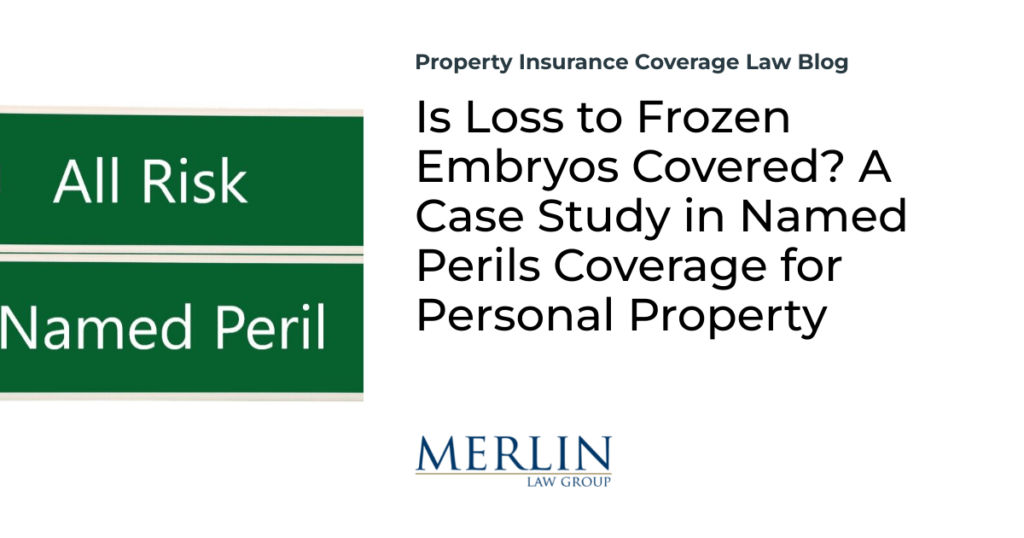Is Loss to Frozen Embryos Covered? A Case Study in Named Perils Coverage for Personal Property

A recent California case involving a claim for a loss to frozen embryos caught my attention.1 This is not a “run of the mill” type of loss. It is also a good case to remind policyholders that most homeowners policies are written on a named peril for personal property loss.
The lesson to remember from this post is that a standard H0-3 homeowners policy covers only “named perils” on contents and personal property. An all-risk insurance policy that covers all risks on both real property and personal property is an HO-5 policy. The HO-5 policy provides much greater coverage for loss to contents and personal property than the standard HO-3 policy.
The case facts are as follows:
Sherlene and Lawrence Wong (the Wongs) had stored some embryos at a facility that kept them in a cryogenic tank that failed to maintain the temperature necessary to store the embryos, following which the Wongs’s [sic] fertility doctor told them they should consider the embryos ‘compromised’ and ‘no longer viable, and lost.’ The Wongs had a homeowners insurance policy with respondent Stillwater Insurance (Stillwater), a specified perils policy providing that ‘We insure for direct physical loss to the property described in Coverage C caused by any of the following perils,’ going on to list 16 specified perils. The Wongs made a claim for property damage, which Stillwater denied.
The HO-3 form policy provided the following coverage for personal property:
We insure for sudden and accidental direct physical loss to property described in Coverage C caused by any of the following perils unless the loss is excluded in SECTION I – EXCLUSIONS.
SECTION I – PERILS INSURED AGAINST
1. Fire Or Lightning
2. Windstorm Or Hail
3. Explosion
4. Riot Or Civil Commotion
5. Aircraft
6. Vehicles
7. Smoke
8. Vandalism Or Malicious Mischief
9. Theft
10. Falling Objects
11. Weight Of Ice, Snow Or Sleet
12. Accidental Discharge Or Overflow Of Water Or Steam
13. Sudden And Accidental Tearing Apart, Cracking, Burning Or Bulging
14. Freezing
15. Sudden And Accidental Damage From Artificially Generated Electrical Current
16. Volcanic Eruption
The court’s fundamental ruling was that there was no proof of physical loss caused by a covered named peril. The court noted the general law on this topic:
The Stillwater policy was, as noted, a ‘specified perils’ policy. According to the leading California insurance commentary, the significance of this is the insured has ‘the threshold burden of proving the loss was caused by a specifically-enumerated peril.’ …As our colleagues in Division One have described it, ‘in litigation, ‘ ‘… the burden is on the insured to prove that an event is a claim within the scope of the basic coverage.’ ’Only after ‘the insured shows that an event falls within the scope of basic coverage under the policy’ [citation] does the burden shift to the insurer to prove the claim is specifically excluded…. ‘[F]or ‘named perils’ policies … the insured bears the burden of proving the loss was caused by the specified peril’].)
There is a lot to this decision regarding proof of physical loss which I will address in tomorrow’s blog post.
Today’s lesson is always to check if the personal property is covered on an all-risk versus named perils basis. Policyholders purchasing insurance should consider purchasing all-risk coverage for contents under an HO-5 endorsement. Insurance agents should always make this option available and known to their clients.
Thought For The Day
All the world is full of suffering. It is also full of overcoming.
—Helen Keller
1 Wong v. Stillwater Ins. Co., No. A162893, — Cal.Rptr.3d —, 2023 WL 4285283 (Cal. App. June 30, 2023).







